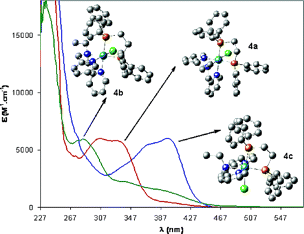The synthesis and isolation of the complex cis,fac-[RuIICl2(bpea)(PPh3)] [3; bpea = N,N-bis(2-pyridylmethyl)ethylamine] and three geometrical isomers of the complex [RuIICl(bpea)(dppe)](BF4) [4; dppe = (1,2-diphenylphosphino)ethane], trans,fac (4a), cis,fac (4b), and mer(down) (4c), have been described (see Chart 1 for a drawing of their structures). These complexes have been characterized through analytical, spectroscopic (IR, UV/vis, and 1D and 2D NMR), and electrochemical (cyclic voltammetry) techniques. In addition, complexes 3, 4a, and 4b have been further characterized in the solid state through monocrystal X-ray diffraction analysis. The molecular and electronic structures of isomers 4a, 4b, 4c, and 4d (the mer(up) isomer) have also been studied by means of density functional theory (DFT) calculations. Furthermore, their low-energy electronic transitions have been simulated using time-dependent DFT approaches, which have allowed unraveling of their metal-to-ligand charge-transfer nature. Complexes 3 and 4a-c are capable of catalyzing H-transfer types of reactions between alcohols and aromatic ketones such as acetophenone and 2,2-dimethylpropiophenone (DP). A strong influence of the facial versus meridional geometry in the bpea ligand coordination mode is observed for these catalytic reactions, with the meridional isomer being much more active than the facial one. The meridional isomer is even capable of carrying out the H-transfer reaction of bulky substrates such as DP at room temperature.
